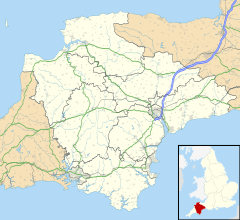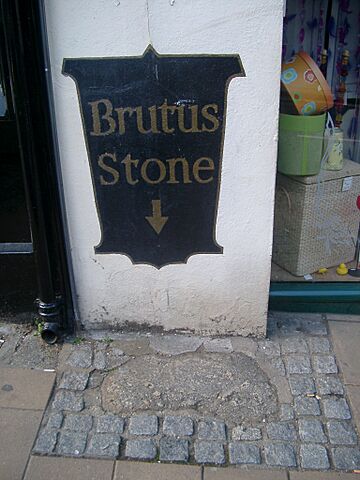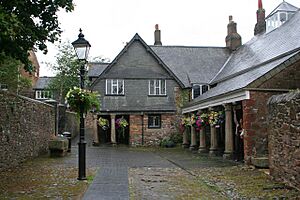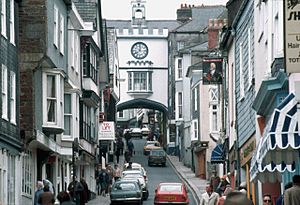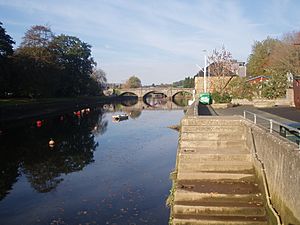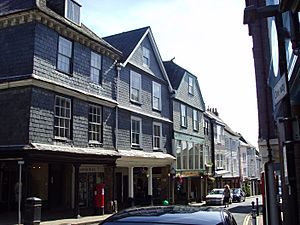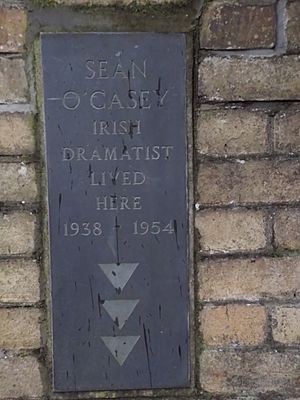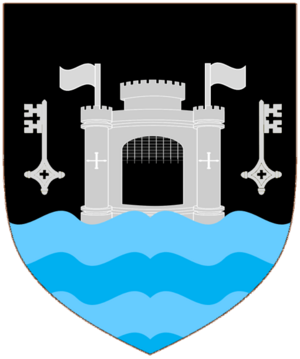Totnes facts for kids
Quick facts for kids Totnes |
|
|---|---|
 The Eastgate over High Street in 2019 |
|
| Population | 9,214 (Census, 2021) |
| OS grid reference | SX805605 |
| Civil parish |
|
| District | |
| Shire county | |
| Region | |
| Country | England |
| Sovereign state | United Kingdom |
| Post town | TOTNES |
| Postcode district | TQ9 |
| Dialling code | 01803 |
| Police | Devon and Cornwall |
| Fire | Devon and Somerset |
| Ambulance | South Western |
| EU Parliament | South West England |
| UK Parliament |
|
Totnes is a lively market town in Devon, England. It sits at the start of the River Dart estuary. This area is known for its beautiful nature. Totnes is about 5 miles (8 km) west of Paignton. It is also about 7 miles (11 km) west-southwest of Torquay. Plymouth is about 20 miles (32 km) east-northeast. Totnes is the main office for the South Hams District Council.
Totnes has a very long history. It dates back to 907 AD. That is when its first castle was built. By the 1100s, it was already a key market town. You can still see its past wealth in the old merchant houses. Many were built in the 1500s and 1600s. Today, Totnes is known for its creative and alternative community. It is a place where people can live a unique lifestyle.
The 2021 census showed Totnes had 9,214 people. This was more than the 8,076 people in 2011.
Contents
Discovering Totnes's Past
Myths and Legends of Totnes
Stories say that Totnes is a very special place. According to an old book from 1136, Brutus of Troy landed here. He was a mythical founder of Britain. On Fore Street, you can see the Brutus Stone. It is a small granite rock. Legend says Brutus stepped onto this stone from his ship. He then said:
Here I stand and here I rest. And this town shall be called Totnes.
This stone is far from the river's highest tides. The story is probably not very old. It was first written down in 1697. The stone might have been where the town crier stood. Or it could have been a boundary stone.
Other old stories also mention Totnes. One tale tells of a fight here. It was between Brutus's general, Corineus, and a giant named Gogmagog. Another story says the Roman general Vespasian landed on the Totnes coast. The town is also mentioned in a prophecy by Merlin.
Ancient and Medieval Totnes
The real history of Totnes begins in 907 AD. King Edward the Elder fortified it. This was part of a defense plan for Devon. The town was built where an old track crossed the river. This crossing was possible at low tide. Between 959 and 1100, Totnes even made its own coins.
After 1066, William the Conqueror gave Totnes to Juhel of Totnes. Juhel likely built the first Totnes Castle. But he lost his lands in 1088 or 1089. This happened because he rebelled against King William II.
The name Totnes was first recorded in 979 AD. It comes from an Old English name, Totta. And ness means headland. In the past, the land around the hill was marshy. This made the hill look more like a "ness" or headland.
By the 1100s, Totnes was an important market town. It was on a main road in the South West. It also had easy river access. This helped it become a busy trading center.
Modern Totnes History
By 1523, Totnes was the second-richest town in Devon. It was the sixteenth-richest in all of England. This shows how important it was.
In 1553, King Edward VI gave Totnes a special charter. This allowed an old Benedictine priory building to be used. It became the Totnes Guildhall and a school. In 1624, the Guildhall was changed into a court. Soldiers stayed there during the English Civil War. Oliver Cromwell even visited in 1646. The Guildhall was also a town prison until 1887. It remained a court until 1974.
In 1990, a big fire happened on the High Street. The historic Eastgate was destroyed. The damage cost about £10 million.
In 2006, Totnes became the first "transition town". This is a special idea developed by Permaculture designer Rob Hopkins. It helps communities prepare for a future with less fossil fuels. Totnes has worked to become more self-sufficient. Many other towns around the world have started similar projects. Totnes also hosts the Sea Change Festival. This music and arts festival has been running since 2016.
How Totnes is Governed
Totnes was given its borough charter by King John. This was likely around 1206. The town celebrated its 800th anniversary in 2006. Totnes lost its borough status in 1974.
Totnes sends one Member of Parliament (MP) to Parliament. In 2009, Totnes was the first place to choose a Conservative candidate in a special public vote. Dr Sarah Wollaston won this vote. She was elected to Parliament in 2010. In 2019, she changed parties. In 2024, Caroline Voaden became the MP for Totnes.
The Greens have represented Totnes on Devon County Council since 2009.
Totnes has a mayor. The mayor is chosen each year by sixteen town councillors. Follaton House, on the edge of town, is the main office for the South Hams District Council. Totnes is twinned with Vire, a town in France. Vire Island on the River Dart is named after it. There is also a joke that Totnes is twinned with the fantasy land of Narnia.
Totnes Geography
The town is built on a hill. This hill rises from the west bank of the River Dart. The river separates Totnes from Bridgetown. Totnes is at the lowest point where the river can be crossed. Here, the river is tidal. It forms a winding estuary down to Dartmouth and the sea. The river stays tidal for about 1 mile (1.6 km) above the town. Then it meets Totnes Weir, built in the 1600s.
Today, there are two road bridges, a railway bridge, and a footbridge over the river. Totnes Bridge is closest to the sea. It is a road bridge built in 1826–28. At low tide, you can see parts of the old stone bridge foundations upstream. This old bridge was likely built in the early 1200s. In 1982, a new concrete bridge was built upstream. It is called Brutus Bridge. Further upstream, a railway bridge carries trains over the river. Next to it is a footbridge, built in 1993. This footbridge leads to the Totnes (Riverside) station. This station is for the South Devon Railway.
Totnes Economy and Culture
Totnes has become a home for many people with an "alternative" lifestyle. It is known as a place where people can live a "New Age" way of life. There are many places for artists, painters, and musicians. The town has a market twice a week. It sells antiques, musical instruments, books, handmade clothes, and local organic food. In 2007, Time magazine called Totnes the "capital of new age chic." In 2005, British Airways magazine called it one of the world's "Top 10 Funky Towns."
In March 2007, Totnes was the first town in Britain to create its own local money. It was called the Totnes pound. This was to help local businesses. Many businesses in town accepted it. This idea was part of the "transition town" concept. The Totnes pound was stopped in 2019.
Totnes has a history of boatbuilding. Between 1998 and 2001, Pete Goss built his large catamaran, Team Philips, here. It was a very advanced boat.
Dartington College of Arts moved away in 2010. This meant less money for the town. But more tourists came to Totnes. They were interested in its status as a "transition town".
Important Totnes Landmarks
Totnes is said to have many listed buildings. These are buildings with special historical importance.
The Norman motte-and-bailey Totnes Castle is owned by English Heritage. It was built during the time of William I. The beautiful St Mary's Church is from the late medieval period. Its tall 120-foot (37 m) tower can be seen from far away. It is made of red sandstone.
A famous part of the town is the Eastgate. This is an arch over the main street. It was an entrance to the walled town in Elizabethan times. It was destroyed in a fire in 1990 but was rebuilt.
The ancient Leechwell still provides fresh water. It was named for its supposed healing powers. The Butterwalk is a covered walkway from the Tudor period. It was built to protect dairy products from the sun and rain. The Totnes Elizabethan House Museum is in an old merchant's house. It was built around 1575.
Getting Around Totnes
The A38 main road is about 7 miles (11 km) west of Totnes. You can reach the town using the A384 and A385 roads. The town is also on the A381 between Newton Abbot and Salcombe.
Totnes railway station is on the Exeter to Plymouth line. You can catch trains directly to London Paddington, Plymouth, and Penzance.
Near the main station is Totnes (Riverside) railway station. This is the start of the South Devon Railway Trust. This railway runs tourist steam locomotives along the River Dart to Buckfastleigh.
Bus services are provided by Stagecoach South West, Tally Ho Coaches, and County Bus. Totnes also has a local minibus service called Bob The Bus.
The River Dart is deep enough for boats to reach Totnes. So, the river was used to bring goods into and out of the town until 1995.
Education in Totnes
King Edward VI Community College, often called KEVICC, is the local secondary school. It shares its name with an older grammar school. On the western edge of town is the Dartington Hall Estate. This used to be home to Schumacher College and Dartington College of Arts. There are also several private schools in the Totnes area. They offer education for primary and secondary students.
Totnes Media
Local TV news comes from BBC South West and ITV West Country. You can get TV signals from the Beacon Hill transmitter.
Local radio stations include BBC Radio Devon (104.3 FM) and Heart West (100.5 FM). There is also Greatest Hits Radio Devon (105.5 FM) and Soundart Radio (102.5 FM). Soundart Radio is a community station.
| Type | Local newspaper |
|---|---|
| Headquarters | Totnes, South Hams, Devon |
| City | Totnes |
| Country | England |
The Totnes Times is a local newspaper. It covers news for the town and the South Hams area. It is published every Thursday. The first issue was on April 7, 1860. Old copies of the newspaper are kept at the Totnes Archive.
Famous People from Totnes
Many interesting people have connections to Totnes:
- Pegaret Anthony, a World War II artist, was born here in 1915.
- Charles Babbage, a famous inventor, went to school in Totnes.
- The novelist Desmond Bagley lived in Totnes for ten years.
- William Brockedon, an artist and inventor, was born here in 1787.
- James Brooke, the first Rajah of Sarawak, spent his last years nearby.
- Actor and dancer Emrhys Cooper grew up in Totnes.
- Actress Sophie Dix was born in Totnes.
- Sir William Elford, 1st Baronet, was a recorder of the borough and an artist.
- Historian James Anthony Froude, who wrote a long history of England, was born in Totnes.
- His brother Richard Hurrell Froude was a theologian.
- TV writer David Gilman lives in Totnes.
- Poet Matt Harvey lives here.
- Rob Hopkins, who started the Transition movement, lives in Totnes.
- Folk singer-songwriter Ben Howard grew up and lives in Totnes.
- Singer-songwriter Cosmo Jarvis was raised in Totnes.
- Comic-book artists Jock, Dom Reardon, and Lee O'Connor live and work in Totnes.
- Hebrew scholar Benjamin Kennicott was born in Totnes.
- Keith Law, a songwriter for the band Velvett Fogg, lives in Totnes.
- Linguist Edward Lye, who wrote an early dictionary of Old English, was born here.
- Rik Mayall, a comedian, lived in Totnes and is buried nearby.
- Admiral Sir Frederick Thomas Michell was mayor of Totnes from 1855 to 1858.
- Captain Reynell Michell was Lord Mayor of Totnes from 1784 to 1802.
- Mike Edwards, a cellist for Electric Light Orchestra, lived in Totnes.
- Joseph Mount, musician and frontman of Metronomy, was born here.
- Playwright Seán O'Casey lived in the town from 1938 to 1954.
- John Prince was a vicar in Totnes. He wrote a famous book called The Worthies of Devon.
- William Reeve, a composer, was an organist at the church.
- Sam Richards, a musician and teacher, lives in Totnes.
- Matt Roper, a stand-up comic, lives here.
- Oliver St John was an important political leader during the English Civil War.
- William Stumbels, an 18th-century clockmaker, lived and worked in Totnes.
- Christopher Titmuss, a meditation teacher and author, lives in Totnes.
- Novelist Mary Wesley spent her final years in Totnes.
- The explorer William John Wills was born in Totnes. A memorial to him is on the Plains.
- Film composer and mystery writer Bruce Montgomery lived in Totnes.
- Poet and writer John Lancaster lives in Totnes.
- Writer and activist George Monbiot lives in Totnes.
Arms
See also
 In Spanish: Totnes para niños
In Spanish: Totnes para niños


